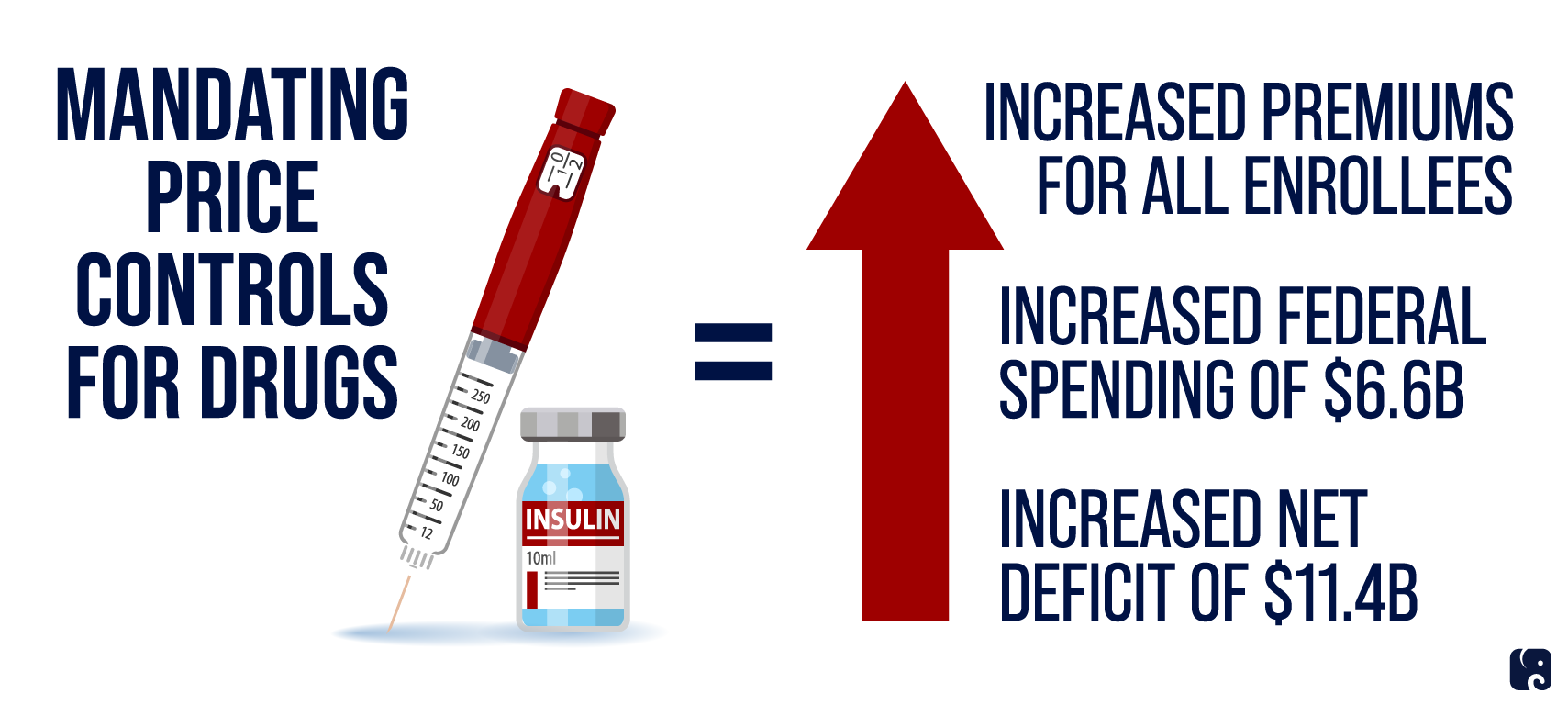Price Controls are Not the Solution for High Drug Costs
KEY TAKEAWAYS
- More than 37 million Americans have diabetes, and approximately 8 million of them take insulin.
- While the average out-of-pocket cost for insulin has decreased for people covered by Medicare Part D and private insurance, some patients struggle to afford their prescriptions.
- Democrats’ solution is more of the same: government price controls that shift costs, increase premiums and the deficit, and hold back innovative treatments and cures for patients.
More than 37 million Americans have diabetes, and about 8 million of them take insulin to manage their condition. As new products have come on the market, prices for insulin have dropped, and insurers offer programs to keep the costs reasonable. Instead of building on these trends to help more people afford their insulin, Democrats are proposing more government mandates and price controls, which run the risk of stifling future cures and patient access.
Price Caps Shift the Cost to Premiums and the Federal Deficit

Patient experience and out-of-pocket costs
Thanks to medical advances, people with diabetes are living longer and in better health. Insulin users today have more flexible options, more accurate dosing tools, and fewer side effects. There are more than 20 insulin products on the market, and they are far superior to the original insulin that was first extracted from animals a century ago.
The average out-of-pocket cost for insulin prescriptions has decreased for commercially insured Americans, from $37 in 2014 to $32 in 2018, a 14% drop. Medicare Part D beneficiaries also have affordable options through the Part D Senior Savings Model, which provides enrollees in participating plans with flat copays of no more than $35 for a range of insulin products.
Some experts attribute the decline in prices to increased competition, as new insulin products have come to market. The arrival of several authorized generics in 2019 and 2020 gave people with diabetes more affordable access to insulin. Last year, another two biosimilar insulin products were approved, and Civica Rx recently announced it will sell three biosimilar insulins for $30 per vial and no more than $55 for a box of five pen cartridges. According to the Food and Drug Administration, biosimilars marketed in the U.S. typically launch with initial prices 15% to 35% lower than the original product. The market is working to create competition and lower prices.
To the extent affordability gaps remain, Congress could pursue targeted solutions that fix discrete problems rather than one-size-fits-all policies with the potential to disrupt coverage for all Americans.
proposals in congress
If policymakers move to address insulin costs, they should keep in mind the potential unintended consequences, including higher premiums, larger deficits, and the risk of stifling innovative treatments and cures. Last week, the Democrat-controlled House of Representatives passed legislation that would cap insulin cost-sharing at $35 a month for Medicare Part D and the commercial insurance market. If these caps were to take effect, insurers would likely have to shift the costs to their customers in the form of higher premiums.
Because Medicare and private insurers would have to cover the difference between the cost-sharing cap and the price of the drugs for their enrollees, and private health plans would face a broad new coverage mandate, the Congressional Budget Office estimates the bill would increase direct government spending by $6.6 billion. This includes higher Medicare costs and higher costs borne by individual market plans, which the federal government subsidizes under Obamacare. The bill would also reduce revenues by $4.8 billion, for a total net deficit increase of $11.4 billion. The Wall Street Journal summarized the legislation’s failings: “Alas the bill misdiagnoses the problem and is a pretext for more political control of drug prices, which won’t serve suffering Americans.” The editorial concluded by quoting former FDA Commissioner Scott Gottlieb, the “ultimate goal is to free patients from insulin.” Government price controls will not lead to a cure for disease.
Democrats were also pushing drug price controls as part of their reckless tax and spending spree last year. This latest bill poses some of the same dangers as that earlier scheme, including the risk of less innovation in pharmaceutical development due to the lower return on investment. Democrats could leave patients, especially those with rare diseases, empty-handed. In the case of insulin, drug companies have developed new methods of delivery, such as inhaled products, and have been working on long-acting insulins requiring administration just once a week. With price controls in place, innovations like these might never come to market.
Senator Schumer has said he would like the Senate to consider an insulin bill during the next work period. Instead of price controls, any policies should be geared toward increasing innovation and market competition to drive down patient costs. Insulin access and affordability could be addressed by creating incentives for the FDA to approve biosimilar insulins faster and by permanently extending the Part D Senior Savings Model and the safe harbor for high-deductible health plans that cover insulin pre-deductible. There are several bipartisan proposals that would reduce out-of-pocket prescription drug costs, including for insulin, without imposing price controls, chilling life-saving innovation, or raising health insurance premiums. Americans who depend on insulin deserve carefully considered solutions, not more Washington control.
Next Article Previous Article
